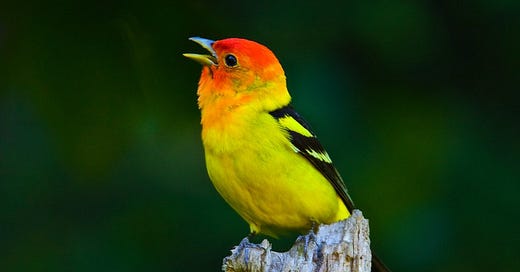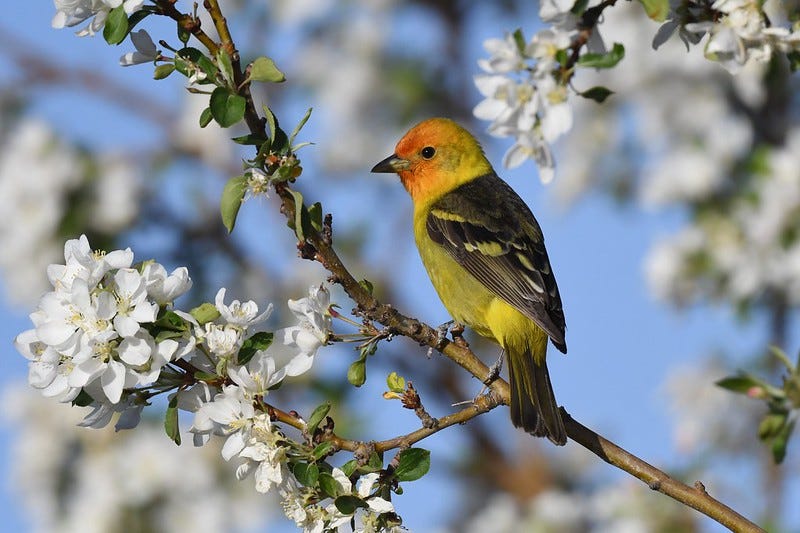
Earlier this month, a friend hit up the group chat with my favorite kind of message. It read: “Cait, I think this could be a future Bird of the Week if it hasn’t already been acknowledged.”
Along with the text was a screenshot of her (hi Vicki!) husband’s (hi Rusty!) latest tweet (private or I would link!), which displayed an absolutely stunning photo of technicolor bird nestled in a tree with the words, “Saw my first western fuckin tanager today.”
LFG!!!!
I played it cool on the thread, but I knew I couldn’t wait a single minute before researching this incredible creature, and couldn’t wait much longer than that before formally introducing it to the hallowed halls of Bird of the Week.
Folks, behold the western tanager:
HOW have we not done this bird before?? Jack previously (and beautifully) covered the Brazilian tanager, aka the Antifa Bird, but we’ve really been sleeping on tanagers otherwise. Seriously, this bird family might get its own month here at the blog at some point because damn, they are top notch birds.
But I’m getting away from the point, and the point is that gazing upon the western tanager is “like looking at a flame.” Have you ever read a more beautiful phrase? Have you ever seen a more beautiful bird?? Have you ever read a phrase that is more perfectly apt for describing a beautiful bird?? My GOD.
I guess I should talk about some facts here so okay, okay, the western tanager can be found—in blessedly bountiful numbers—in the coniferous forests of western North America (Vicki and Rusty spotted theirs near their patio in Oregon!). The western tanager’s eastern counterpart is the scarlet tanager, and I suggest you click through to see it, and then I suggest you write us a letter urging us to do tanager month (picture me pounding the table shouting “tanager month”) because they freaking deserve it.
Western tanagers are known in part for their distinctive call, which is not unlike an American Robin's, but is a bit more hurried with a rougher tone. Some describe it as a “chuckling” or “rattling” call, but listen for yourself and see what you think. I would describe it as short, sing-songy phrases, with clear pauses in between, like a conductor masterfully directing a superbly talented flutist who is as artful as they are forceful, and in total command of the instrument. Okay I’m getting too enraptured, time for a video break:
We’ve already established that western tanagers are tree dwellers, but they’re not just any tree dwellers: they can be found occupying branches and bopping around at elevations as high as 10,000 feet. I guess there’s no such thing as fear when you’re permanently sporting Guy Fieri’s dream color palette (and Discourse Blog’s too if we’re being real).
Speaking of those colors. Those colors!! The western tanager gets its scarlet crown from a rare pigment called rhodoxanthin, which they get from the insects they feed on, who in turn get it from the conifers and other plant life they feed on. Western tanagers also snack on fruits and seeds in the winter months, but insects occupy the bottom rung of their food pyramid. Crazy that on the flipside, humans get our hair color from bread.
I’ll be honest, behaviorally, western tanagers aren’t that notable. In many ways they are a very typical bird, which is fine, because visually and sonically, they are in their own class. The one thing I did want to note is that western tanagers are apparently “seasonally monogamous” which is cool, because it means they participate in cuffing season. Birds, they’re just like us!
That said, we really don’t need western tanagers to have a robust social life, unique mating rituals, or fascinating hobbies, because they look like this. When you’re hot, you don’t need to be interesting. Case closed.
Are you a friend of mine and/or Discourse Blog reader with a killer nominee for BOTW? Text me or write to us at hello@discourseblog.com. And as always, you can check out our complete Bird of the Week list here.





















Unassailable logic! And yes, I vote for Tanager Month.
TANAGER MONTH